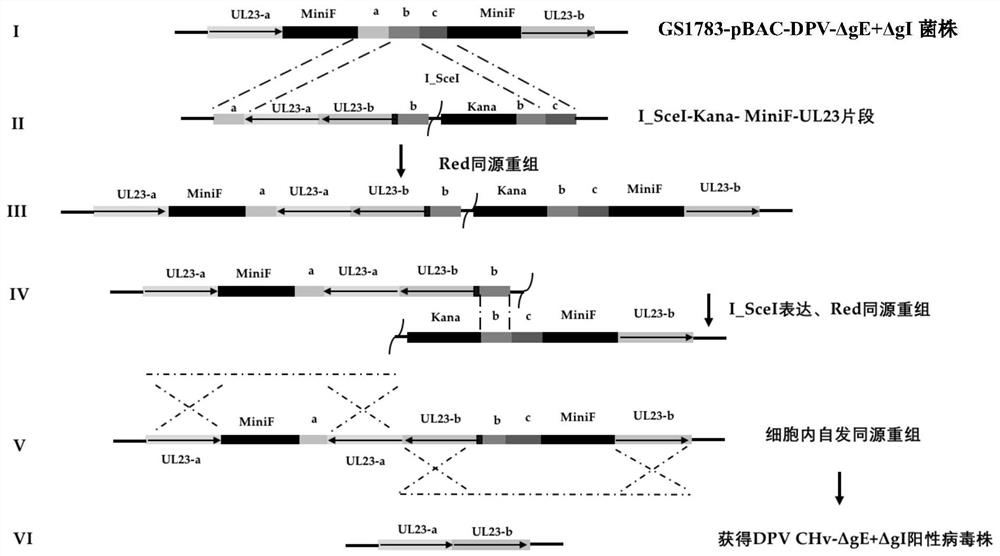Duck plague virus ge and gi double gene traceless deletion strain dpv CHv-ΔgE+ΔgI and its construction method
A duck plague virus and construction method technology, applied in the field of genetic engineering, can solve problems such as residual bases and residual MiniF elements
- Summary
- Abstract
- Description
- Claims
- Application Information
AI Technical Summary
Problems solved by technology
Method used
Image
Examples
Embodiment 1
[0060] Example 1 Preparation of duck plague virus gE and gI double gene scarless deletion strain DPV CHv-ΔgE+ΔgI
[0061] DPV CHv-ΔgE+ΔgI double gene scarless deletion strain DPV CHv-ΔgE+ΔgI of duck plague virus gE and gI, and its construction method includes the following steps:
[0062] 1. Preparation of GS1783 electrotransformation competence, and electrotransformation of pBAC-DPV plasmid
[0063] (1) Resuscitate E. coli with pBAC-DPV plasmid in LB solid medium containing chloramphenicol, and culture at 37°C overnight; single colonies are inoculated into LB liquid medium containing chloramphenicol, and culture at 37°C overnight;
[0064] (2) Extract the pBAC-DPV plasmid according to the QIAGEN Plasmid Midi Kit operating instructions;
[0065] (3) Resuscitate GS1783 cryopreserved bacteria in LB solid medium, and cultivate overnight at 30°C;
[0066] (4) Pick a single colony of GS1783 and inoculate it in 5 mL of LB liquid medium, and culture at 30°C overnight to obtain seed...
Embodiment 2
[0202] Example 2 Detection of virus quantity after inoculation of 7-day-old ducks with traceless deletion strain DPV CHv-ΔgE+ΔgI
[0203] The gE, gI gene and MiniF element traceless deletion strain DPV CHv-ΔgE+ΔgI was inoculated into DEF cells at 0.01 MOI, and the cells were collected 120 hours after inoculation, and the cells were frozen and thawed twice, and the TCID was determined. 50 Afterwards, 2MOI DPV CHv-ΔgE+ΔgI deletion virus was used to inoculate 7-day-old ducks intramuscularly, and the blood, liver and spleen of the ducks were collected at 24h, 48h, 72h, and 96h respectively, and extracted according to the instructions of TaKaRaMiniBEST Viral RNA / DNA Extraction Kit Ver.5.0 tissue DNA. The identification primers gE-F and gI-R were used to detect whether duck liver virus was a double deletion virus of gE and gI genes at 48h after challenge (see Figure 5 ), primers and Taq probes were identified by UL30 QPCR, and the amount of virus in blood, liver and spleen at diff...
PUM
 Login to View More
Login to View More Abstract
Description
Claims
Application Information
 Login to View More
Login to View More - R&D
- Intellectual Property
- Life Sciences
- Materials
- Tech Scout
- Unparalleled Data Quality
- Higher Quality Content
- 60% Fewer Hallucinations
Browse by: Latest US Patents, China's latest patents, Technical Efficacy Thesaurus, Application Domain, Technology Topic, Popular Technical Reports.
© 2025 PatSnap. All rights reserved.Legal|Privacy policy|Modern Slavery Act Transparency Statement|Sitemap|About US| Contact US: help@patsnap.com



